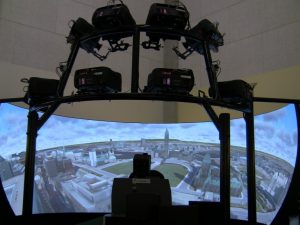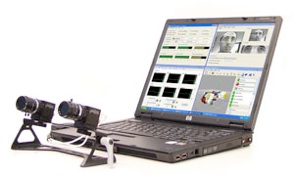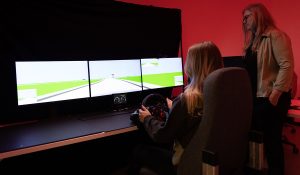Over the past twenty years or so, the number of licenced drivers aged 65 or older has increased nearly 70 per cent!
Canadian and U.S. population statistics both point to our aging population, with significant increases in all age subcategories (65-74,75-84, 85+), and research shows many of those seniors are still driving: in the 85-and-over age group, 67 per cent of men and 26 per cent of women had a licence to drive.
As one way to keep people the road safer, drivers over 80 years of age and over must renew their licence every two years (in Ontario, for example). Another way is to harness high-tech simulators, interactive technologies, and data analytics about driving to help senior citizens build and maintain safe driving habits.
While most seniors do drive carefully, statistics show that drivers aged 70 or older have a higher accident rate per kilometre than any other age group (except young male drivers; sadly still the group with the highest risk and most fatal crashes).
Driving may be a great thrill for young men, but it is often a real need for senior citizens. It’s not just about getting to the store – important enough – but also about maintaining personal connections and interactions with family, friends and the community at large. The physical connectivity that driving can enable is a big part of mental health, particularly for people isolated in rural or remote areas where public transit is not available, or for those in urban settings where funding and service cutbacks make public transit a less useful option.
At Carleton University in Ottawa, for example, a high-tech approach to assess the abilities of older drivers is underway in sophisticated driving simulators with giant video screens, touch sensitive controls and eye tracking devices, as well as in actual on-road studies at the nearby Area X.O. a private gated site some 750 hectares in size and a real-world 16 km test track.
Carleton’s Advanced Cognitive Engineering (ACE) Laboratory team is using the technology to better understand the cognitive changes that affect driver performance as people age. A key deliverable from their efforts will be a set of criteria that older adults, their families, and health practitioners can use to determine when a driver should be reassessed and how technology can help keep them safe on the road, supporting their continued independence.
“It is often very difficult for a person to self-reflect on their own driving abilities. It is equally challenging for a family member to judge whether an elderly relative is having difficulty driving,” explained ACE director Chris Herdman in a release. “However, there are new ways to gather information about drivers that can tell us when they’re experiencing difficulties and how their abilities are changing. We want to make sure we can provide relevant and timely feedback to elderly drivers and to their families.”
The researchers have received funding from the National Research Council Canada’s Aging In Place Challenge program and Canadian Institutes of Health Research for this project after completing related studies in collaboration with Transport Canada.

Driving test participants have their hands on a steering wheel and look ahead at a realistic simulated streetscape.
In a theatre-like driving simulator, researchers study people’s driving performance, including how they react to sudden, surprising or challenging conditions, like a ball rolling across the road – is a youngster running after it? Or a crossing signal suddenly starting to flash – how close is the train?
Seated, the test participants have their hands on a steering wheel and look ahead at a realistic simulated streetscape on giant wraparound video monitors in what is called the Broad-Angle Display System (BADS).
BADS is often used for flight simulation support and cognitive experimentation in virtual environments; it’s now part of driver’s ed!

Mounted projectors and giant wraparound video screens are used in the Broad-Angle Display System (BADS).
Eight high definition 1080p projectors fill the 14 ft. tall, 180-degree curved screen with scenes from highly immersive visual environments. Hardware can be configured and software programmed in several ways, much like working with professional visual effect generators, commercial gaming engines and image software, creating different traffic settings and driver reaction tests.
The simulator can determine when the driver notices an event and how quickly they take action, based partly on tracking eye movements.
 The FaceLAB 4.3 system from Seeing Machines allows researchers to track eye, head, and eyelid movement in real time. It uses two lensed cameras, three IR sensors and no-head-mounted parts. The eye tracker measures such parameters as user’s sight direction, positions and diameters of pupils, frequency and time of blinking. Participants also have their heart rate monitored.
The FaceLAB 4.3 system from Seeing Machines allows researchers to track eye, head, and eyelid movement in real time. It uses two lensed cameras, three IR sensors and no-head-mounted parts. The eye tracker measures such parameters as user’s sight direction, positions and diameters of pupils, frequency and time of blinking. Participants also have their heart rate monitored.
All the simulator tests can be similarly conducted in a highly wired and sensored car on the 16-km roadway network at Area X.O.
Data collected by the Carleton researchers can be analyzed along with appropriately acquired driving data collected by many vehicles on the road these days. Machine learning techniques can be applied to classify driver habits, like lane changes or accelerator taps, and driver behaviour changes, such as slower speeds and longer trip durations.
Carleton says such data is aggregated to protect the privacy of drivers and only shared in accordance with strict ethical standards.
Such test and data analysis help inform what are called Driver Safety Teams, another key deliverable from Carleton and Herdman’s companion three-year SENSE-MD project. The team consists of an elderly driver, designated family member, and a health practitioner. Team member get regular and relevant information that helps them decide whether someone is still able to drive safely.
As more insights into the driving habits and abilities of an aging population are amassed, and as autonomous or semi-autonomous driving technologies make their way to market, human factors must play an equal role with engineering decisions and policy choices ones to ensure we all drive safely, no matter our age.
# # #

Carleton’s Advanced Cognitive Engineering (ACE) Laboratory team is using simulation technology to better understand the cognitive changes that affect driver performance as people age.
-30-



